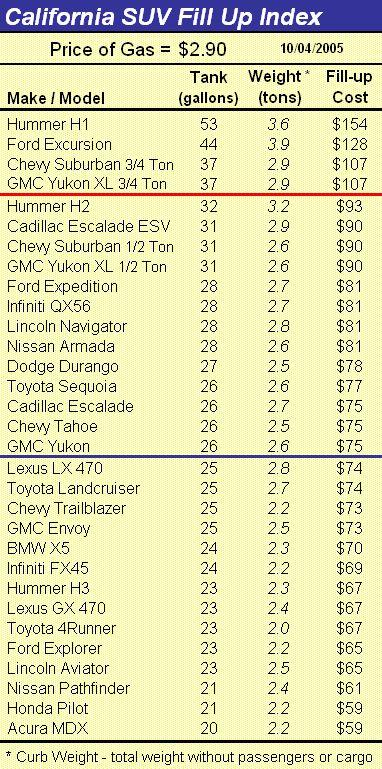The California SUV Fill-Up Index - $2.90
Tuesday, October 04, 2005
After reading this and this a couple days ago, we figured we'd better get about the business of updating our California SUV Fill-Up Index before we fall hopelessly behind in our promise to provide an update with each ten cent rise in gasoline prices.
Based on a very unscientific survey in the last day or two, it appears that we are erring a bit on the low side by calling it at $2.90 for regular unleaded, however, this is reasonably close to what consumers are paying.
As discussed in previous posts on this subject here and here, the real action for the near term is going to be around the $75 mark. As you can see in the updated chart, the Toyota Sequoia has now breached this level along with three General Motors behemoths:
Speaking of General Motors behemoths, this report on September auto sales appeared yesterday. Should it be surprising that Chevy Tahoe sales were off 50 percent from the same period last year? A summer of employee discounts surely had an impact on September sales, but it does look like gas prices are starting to influence consumer automobile purchases.
Ahhh... the markets are working their magic.
Chrysler seems to have done reasonably well last month. Not coincidentally, to be sure, they have only one entry in our index - the Dodge Durango.
With a number of popular Ford products also high on the index, this is starting to feel like the 70s and 80s all over again. Back then it was models like the Datsun B210 that Americans were buying. Today, the redesigned Honda Civic adds to Japanese market share while American manufacturers struggle with outdated products.
Environmentally Friendly SUVs
Most of the new $75+ fill-up SUVs have such outdoorsy, environmentally friendly sounding names - Sequoia, Tahoe, Yukon. It sounds like you're out in the wilderness, far from civilization - the smell of pine trees in the air, listening to the crackling of wood in a fireplace, and gazing at the stars - not on the way home from work riding someone's bumper at 75 miles an hour in the fast lane trying to make it to the PTA meeting on time.
Even Escalade sounds like something light and agile, not like something weighing nearly three tons without driver, passengers, or cargo.
And, that Toyota... it does sound strange to say, "I just spent $75 to fill up my T0yota"
You'll notice that we've replaced the fuel economy column with curb weight. There were some questions about the accuracy of the fuel economy claims provided by the manufacturers, which we had dutifully transcribed in the previous version of this chart. Some owners commented that their mileage was not in the mid-teens, but the low-teens. We were unable to successfully resolve these inconsistencies, but we were sympathetic.
We're guessing that most owners haven't weighed their SUVs lately, and that the curb weight numbers provided will be less controversial.
As for the fill-up process itself, it has recently come to our attention that for some reason, at least in California, the maximum amount that gas stations allow to be charged on a credit card for a single transaction is $60. What this must mean is that in order to get a full load of gas into an empty tank for most of the SUVs above, the owner must insert their credit card, select the fuel grade, pump the gas, complete the transaction, and then repeat.
What a pain!
Worse yet, to completely fill the Hummer H1 and Ford Excursion, this would actually require three complete transactions at today's prices. That must take a fair amount of time, but with today's prices, most H1 and Excursion owners probably don't bother with the third transaction - after $120, their tanks are full enough.
That may not be true in the future.











![[Most Recent Quotes from www.kitco.com]](http://kitconet.com/charts/metals/gold/t24_au_en_usoz_2.gif)
![[Most Recent Quotes from www.kitco.com]](http://kitconet.com/charts/metals/silver/t24_ag_en_usoz_2.gif)
![[Most Recent USD from www.kitco.com]](http://www.weblinks247.com/indexes/idx24_usd_en_2.gif)

3 comments:
With my car, fuel efficiency appears to be very sensitive to the number of short trips (including light stops) I make. My typical driving profile is short trips (around or under 5 miles), and longer freeway tours. When I'm not driving "enough" on the freeway, mileage goes down noticeably. With long freeway-only trips that I can individually measure when filling at the destination, I can significantly exceed the rated mileage.
The official mileages are for sustained operating conditions.
I just tried to lift my Chevy Trailblazer - I think it weighs more than 2.2 tons.
Hummer H1 doesn't belong to this particular table. It's diesel powered. Diesel fuel often costs more that premium gasoline. What realworld mileage H1 is also not clear. Diesel efficienc vs Hummer's weight and aerodynamic profile...
Post a Comment